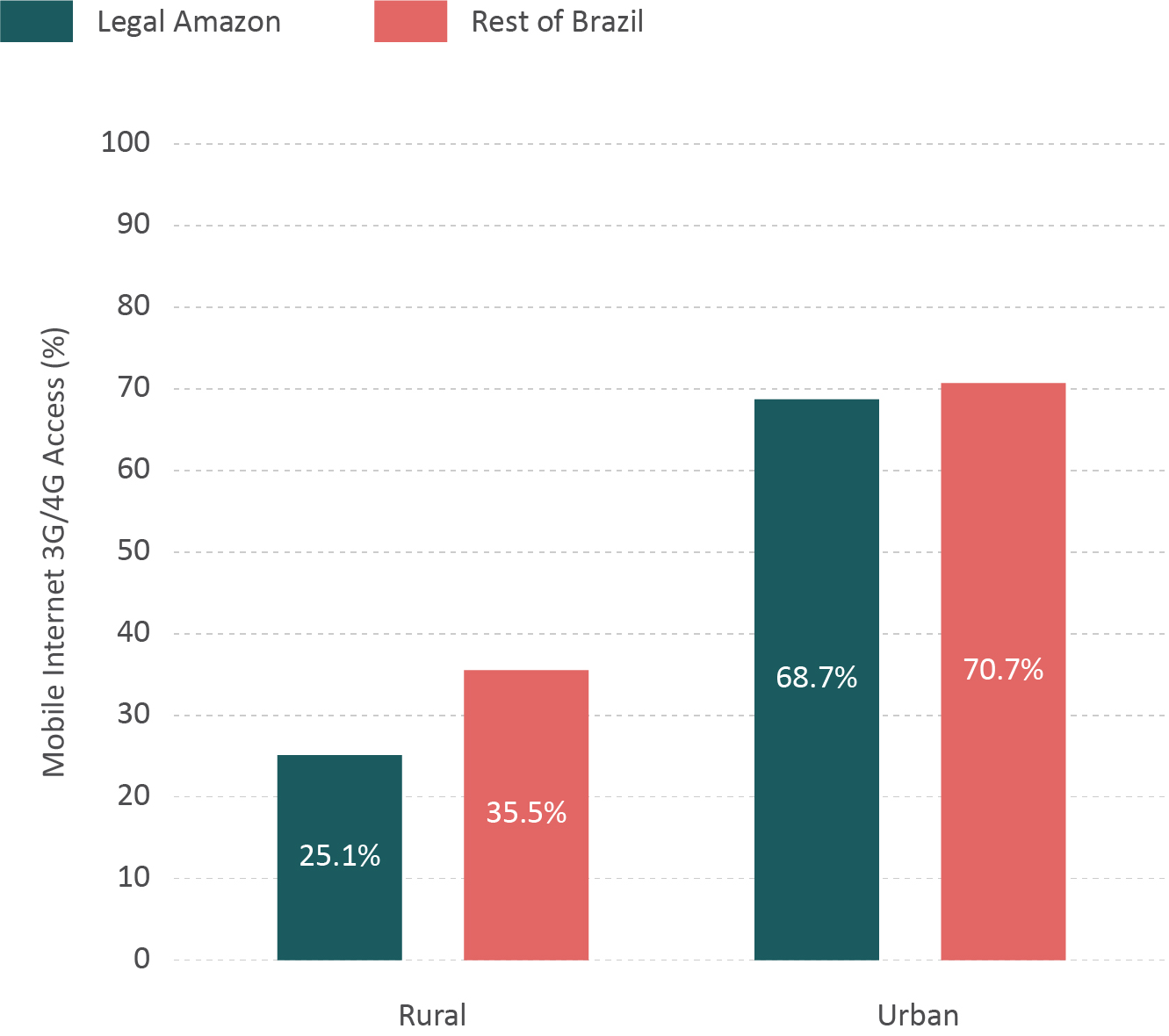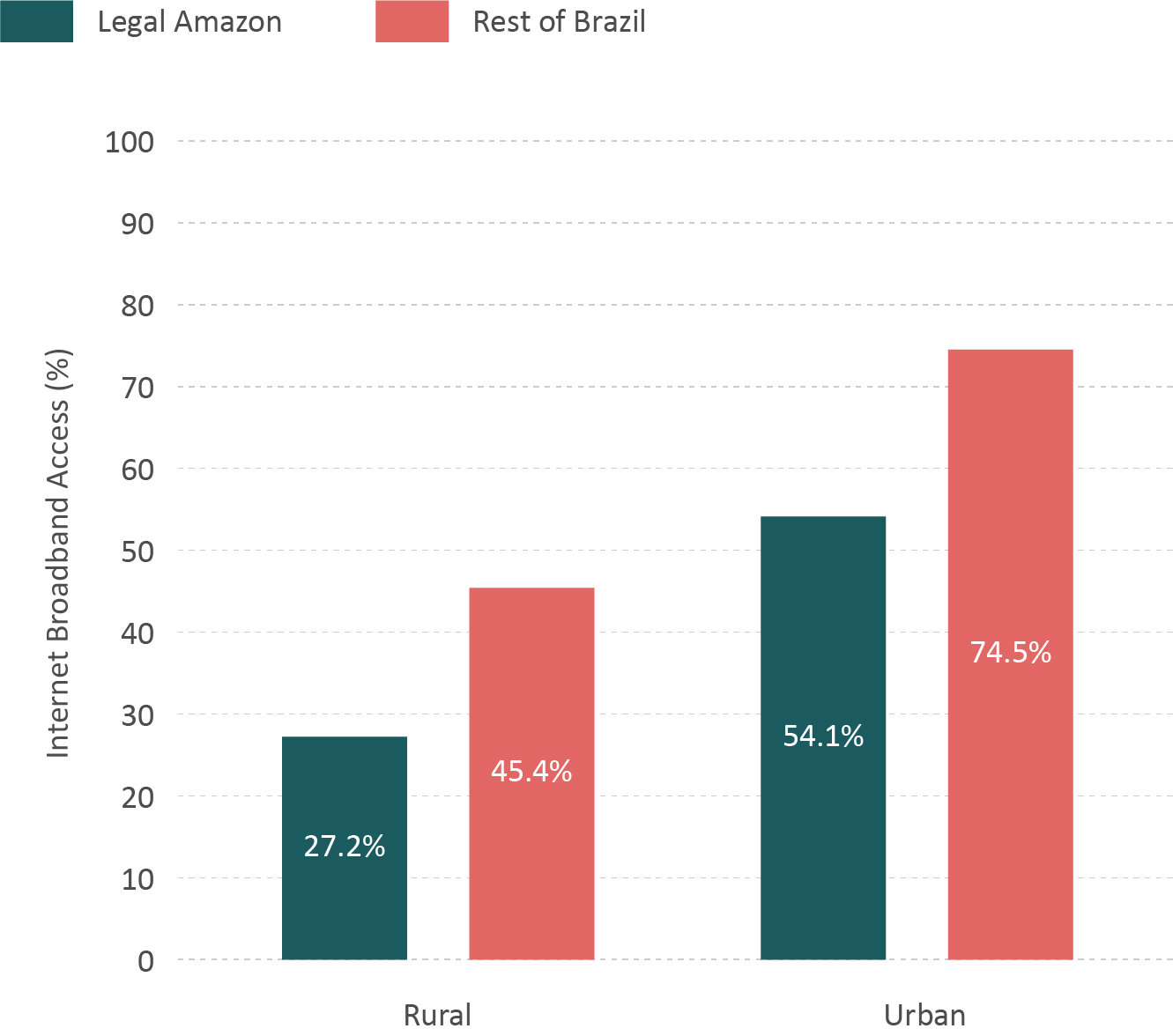The Legal Amazon is the most isolated region in Brazil. Reducing this isolation and improving the economic ties between the Legal Amazon and other parts of the world is key to boosting the region’s economy and creating jobs and income for the local population. Traditionally, investment in logistics infrastructure, and particularly in roads, was the primary initiative for improving the accessibility of isolated areas. However, technological progress and changes in workplace organization (for example, working remotely, outsourcing services such as call centers, etc.) have made investing in phone and high-speed internet services an important part of improving the accessibility of areas such as the Amazon.
Expanding access to phone and high-speed internet services is strategic for the Amazon for two reasons. First, phone and internet services allow for a significant increase in accessibility without the socio-environmental risks associated with investing in traditional logistics in the region.[1] Secondly, broadband infrastructure has the potential to increase income and job opportunities for local workers and entrepreneurs. This is especially significant given the region’s weak economy and rising unemployment.[2]
This document discusses how expanding access to phone and high-speed internet services has the potential to boost the economy in the Legal Amazon. This brief summarizes the available evidence on the impact of information and communication technologies on businesses and workers with an emphasis on the effects observed in both the rural and urban sectors. Next, it discusses how access to this technology in the region, as well as improvements to this access, can boost the economy of the Legal Amazon.
Economic Impact of Information and Communication Technologies (ICT)
Advances in information and communication technologies (ICT) have profoundly changed the economy in recent decades. This progress has made it possible for workers, businesses, and organizations in different locations to collaborate and market their services to much more distant markets in real time. It has also allowed producers to obtain information about markets and technology at a much lower cost than before.[3]
In developed countries, there is evidence that the growth of this technology has led to productivity gains.[4],[5] But it has also created more inequality and polarization in the job market,[6],[7] since it has benefitted workers with higher levels of education more than those with less education. On the other hand, in developing areas, there is evidence that the arrival of modern ICT has led to numerous benefits for workers and businesses from different sectors and levels of education. These effects have been observed from the outset of both mobile phone and high-speed internet services.
The literature on the effects of expanding mobile phone services suggests that it benefits small producers by improving access to information. Evidence from the fisheries sector in the state of Kerala in India reveals that the dissemination of cellular phones gave fishermen easier access to information on their consumer markets, considerably reducing price dispersion between neighboring markets, raising profits by nearly 8% and reducing prices by about 4%.[8] In African countries such as Kenya and Rwanda, there is evidence that small-scale farmers benefitted from the dissemination of cellular phones. This gave them easier access to rural extension services, which fostered the adoption of modern practices that resulted in productivity gains of around 4%.[9]
The literature also suggests that the expansion of mobile phone and internet services has enabled the emergence of mobile financial services that facilitate risk management for vulnerable populations. Evidence from Kenya suggests that the introduction of a mobile financial service called M-PESA considerably increased the number of transfers among the population, improving risk management, increasing savings, and driving an increase in consumption and a reduction in poverty.[10],[11]
Meanwhile, the literature on expanding broadband internet services in developing countries suggests that it generates numerous benefits as well. Data from various African countries indicates that individuals located in closer proximity to areas with better access to broadband internet services are 3 to 13 percentage points more likely to be employed. The increase in employment also benefits individuals with different levels of education and largely results from the greater number of high-quality jobs. Data from companies suggest that these effects are related to two developments: the increased productivity of existing companies and the entry of new companies into the market. It also suggests that businesses use improvements to internet infrastructure to improve communication with clients, increase exports, and invest in worker training.[12]
Evidence from Chinese companies corroborates the findings from African countries. Data on the expansion of faster internet speeds in China suggest that access to high-speed internet increases exports, apparently due to improved communication between businesses, their consumers, and their suppliers.[13]
In addition to the effects it has on companies and their productivity, access to high-speed internet also appears to benefit individuals and their efforts to find work. Data from a program that subsidizes internet costs for low-income individuals in the United States indicates that better internet access helps people look for work, reduces the likelihood that they will be unemployed, and increases their income.[14]
Mobile Phone and High-Speed Internet Services in the Legal Amazon
The empirical studies cited above suggest that investing in phone and internet infrastructure in the Legal Amazon could be key to boosting the local economy. Two types of investment appear especially important if the Legal Amazon is to benefit from ICT’s potential to connect markets and reduce isolation.
The first is an investment in improving the quality of mobile internet service in remote and less-populated parts of the region. Even though access to cellular phones is practically universal, data from PNAD-Continua (the annual Brazilian National Household Sample Survey) show that only a fourth of residents in rural areas of the Legal Amazon have access to 3G or 4G mobile internet (Figure 1). This is ten percentage points less than what has been seen in the rest of the country and appears to reflect issues of supply related to the lower availability of antennas in the region.[15]
Figure 1. Access to 3G/4G Mobile Internet

Source: CPI/PUC-Rio with data from PNAD-Contínua, 2022
The second type of investment needed is to expand access to broadband internet services in urban areas. The data from PNAD-Continua indicates that only 55% of residents in urban areas and 45% of residents in rural areas of the Legal Amazon have access to broadband internet (Figure 2). These numbers are 20 and 18 percentage points lower, respectively, than the rest of the country, and largely appear to reflect issues related to the cost of service.
Figure 2. Access to Broadband Internet

Source: CPI/PUC-Rio with data from PNAD-Contínua, 2022
The international evidence, along with the low quality and low availability of phone and internet services in the Legal Amazon, suggests that improvements to infrastructure that increase quality and availability and reduce the cost of these services have a great potential to decrease isolation and boost the region’s economy. And, equally importantly, these improvements can be made without the environmental costs typically associated with investments in other types of infrastructure such as building roads and railways.
[1] Araujo, Rafael, Arthur Bragança, and Juliano Assunção. Acessibilidade na Amazônia Legal: Delimitação da Área de Influência e Risco Ambiental. Amazônia 2030, 2022.
[2] Alfenas, Flavia, Francisco Cavalcanti, and Gustavo Gonzaga. Mercado de trabalho na Amazônia Legal: Uma análise comparativa com o resto do Brasil. Amazônia 2030, 2020.
[3] Raja, Siddhartha, Saori Imaizumi, Tim Kelly, Junko Narimatsu, and Cecilia Paradi-Guilford. Connecting to Work: How Information and Communication Technologies Could help expand employment opportunities. World Bank, 2013.
[4] Jorgenson, Dale W., Mun S. Ho, and Kevin J. Stiroh. “A retrospective look at the US productivity growth resurgence”. Journal of Economic Perspectives 22, no. 1 (2008): 3-24.
[5] Syverson, Chad. “What Determines Productivity?”. Journal of Economic Literature 49, no. 2 (2011): 326-65.
[6] Autor, David H., Lawrence F. Katz, and Melissa Schettini Kearney. “The Polarization of the US labor Market”. American Economic Review 96, no. 2(2006).
[7] Goos, Maarten, Alan Manning, and Anna Salomons. “Explaining Job Polarization: Routine-Biased Technological Change and Offshoring”. American Economic Review 104, no. 8 (2014): 2509-26.
[8] Jensen, Robert. “The Digital Provide: Information (Technology), Market Performance, and Welfare in the South Indian Fisheries Sector”. The Quarterly Journal of Economics 122, no. 3 (2007): 879-924.
[9] Fabregas, Raissa, Michael Kremer, and Frank Schilbach. “Realizing the Potential of Digital Development: The Case of Agricultural Advice”. Science 366, no. 6471 (2019).
[10] Jack, William and Tavneet Suri. “Risk Sharing and Transactions Costs: Evidence from Kenya’s Mobile Money Revolution”. American Economic Review 104, no. 1 (2014): 183-223.
[11] Suri, Tavneet and William Jack. “The Long-Run Poverty and Gender Impacts of Mobile Money”. Science 354, no. 6317 (2016): 1288-1292.
[12] Hjort, Jonas and Jonas Poulsen. “The Arrival of Fast Internet and Employment in Africa”. American Economic Review 109, no. 3 (2019): 1032-79.
[13] Fernandes, Ana M., Aaditya Mattoo, Huy Nguyen, and Marc Schiffbauer. “The Internet and Chinese Exports in the Pre-Ali Baba Era”. Journal of Development Economics 138 (2019): 57-76.
[14] Zuo, George. “Wired and Hired: Employment Effects of Subsidized Broadband Internet for Low-Income Americans”. American Economic Journal: Economic Policy 13, no. 3 (2021): 447-82.
[15] Bragança, Arthur and Mateus Morais. Redefinindo Prioridades dos Planos de Infraestrutura do Estado do Pará. Rio de Janeiro: Climate Policy Initiative, 2022.

